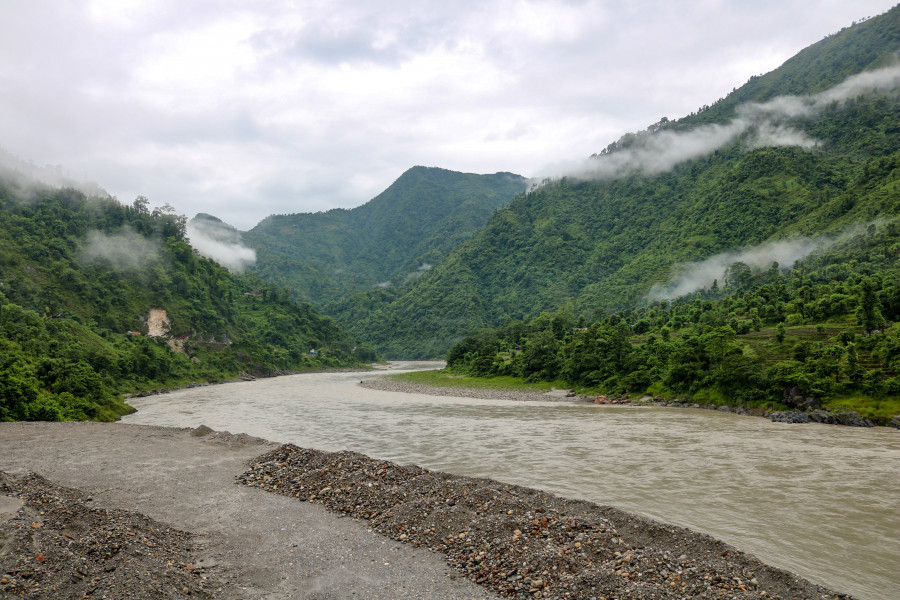Money
Access tunnel of 140 MW Tanahun hydro project built
The $505 million project can generate energy for six hours daily during the dry season.
Samjhana Rasaili & Basant Pratap Singh
Tanahun hydropower project has built the access tunnel as a part of its first phase of infrastructure construction.
The 140-megawatt project is being constructed in Damauli.
According to the project, the tunnel is 436-metre-long with a 7-metre diameter of entrance.
Rajabhai Shilpakar, project chief, said that the tunnel will facilitate transporting construction materials and equipment to the upper side of the proposed dam construction area.
In the first phase, a 140-metre-tall dam will be built.
The first blast to open the access tunnel was conducted in March 2022. The tunnel work, however, was halted for 48 days due to the lack of explosives. The first package—a 140 metre-tall dam and other structures — is being constructed by a joint venture of Song Da Corporation, Vietnam and Kalika Construction, Nepal.
The project said that the work for the 539.8 metre-long diversion tunnel-1 under the second package has been started.
The second package includes the construction of the tunnel, powerhouse along with the installation and operation of hydromechanical and electromechanical equipment which has been awarded to Sinohydro, China.
Under the third package, the contract for the construction work of a 220 KV double circuit transmission line from Damauli to Bharatpur in Chitwan has been awarded to KEC International, India.
The project is targeted to be completed by June 2026.
Tanahun Hydropower Limited, the developer of a 140-megawatt scheme, has signed a power purchase agreement (PPA) with the Nepal Electricity Authority to sell the electricity generated by the plant.
As per the PPA, the power utility will pay Tanahun Hydropower Rs12.40 per unit during the dry season, which lasts from December to May, and Rs6.08 per unit during the wet season, which lasts from June to November.
The PPA also includes a provision under which Tanahun Hydropower can increase the power purchase rate by 3 percent annually for eight years after it commences commercial generation. After the increase, the Nepal Electricity Authority will have to pay Rs15.38 during the dry season and Rs7.54 during the wet season.
The Tanahun Hydropower Project will be one of the biggest reservoir-type projects in the country with an estimated annual energy generation capacity of 587.7 GWh in the first 10 years of operation.
The project can generate energy for six hours daily during the dry season. The project is being built using a credit facility extended jointly by the Asian Development Bank, Japan International Cooperation Agency and European Investment Bank (EIB).
The total cost of the project, including transmission lines and rural electrification, is $505 million.
Asian Development Bank is providing $150 million, Japan International Cooperation Agency $184 million, European Investment Bank $80 million while the government and Nepal Electricity Authority are injecting $80.6 million into the project.
“The project has achieved nearly 35 percent of physical progress,” said Shilpakar.
Meanwhile, two hydro projects in Kalanga Gad river in Bajhang, built by the private sector, have started generating electricity.
The Kalanga Gad hydropower project, which started construction in 2017 aims to generate 65 MW of electricity—including 15.33 MW from Kalanga Gad, 38.46 MW from Upper Kalanga Gad and 10.70 MW from Upper Sanigad.
Bibas Amatya, managing director of Sunam Infrastructure Construction, which was awarded the project, said that the power of Upper Kalanga with a capacity of 38 MW was connected to the national grid on January 31.
Similarly, the electricity generated by the 15MW Kalanga Gad project was connected to the national grid on January 25.
The work of the 10 MW Sanigad hydropower project is yet to be completed.
The electricity produced by this project has been sent to the Balach substation in Baitadi through a 132 kV transmission line. The length of the transmission line is 37.5 km.




 9.12°C Kathmandu
9.12°C Kathmandu














%20(1).jpg&w=300&height=200)
